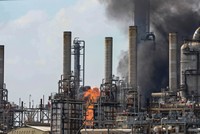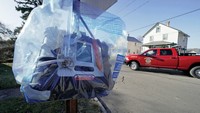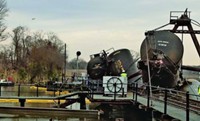Advertisement
Grab your lab coat. Let's get started
Welcome!
Welcome!
Create an account below to get 6 C&EN articles per month, receive newsletters and more - all free.
It seems this is your first time logging in online. Please enter the following information to continue.
As an ACS member you automatically get access to this site. All we need is few more details to create your reading experience.
Not you? Sign in with a different account.
Not you? Sign in with a different account.
ERROR 1
ERROR 1
ERROR 2
ERROR 2
ERROR 2
ERROR 2
ERROR 2
Password and Confirm password must match.
If you have an ACS member number, please enter it here so we can link this account to your membership. (optional)
ERROR 2
ACS values your privacy. By submitting your information, you are gaining access to C&EN and subscribing to our weekly newsletter. We use the information you provide to make your reading experience better, and we will never sell your data to third party members.
Safety
Safety questions remain after Ohio train derailment
A controlled release and burn of vinyl chloride from 5 railcars prompted an evacuation order
by Rick Mullin
February 9, 2023
| A version of this story appeared in
Volume 101, Issue 6
UPDATE: C&EN published a second story on the impact of the train derailment on Feb. 17, 2023.

An evacuation order issued following the derailment of a Norfolk Southern freight train carrying vinyl chloride in Ohio was lifted Feb. 8 after state and federal authorities determined that air and water quality were safe for residents to return to their homes. But questions remain about the safety of transporting the hazardous chemical.
People living near the accident, which occurred Feb. 3 in East Palestine, Ohio, a town of about 4,700 residents on the Pennsylvania border, began leaving immediately as a column of black smoke rose over town. In an effort to avoid an explosion, railroad and state authorities began a controlled release and burn of the vinyl chloride Feb. 6. Earlier that day, the governors of Ohio and Pennsylvania ordered an immediate evacuation of a 1- by 2-mile area that crossed the state line.
In all, about 50 cars—20 of which were carrying hazardous materials—left the tracks in the accident. Of most concern were the 5 carrying vinyl chloride. In a statement announcing the evacuation order, Ohio governor Mike DeWine warned that people closest to the derailment faced “grave danger of death.”
While vinyl chloride itself is a carcinogen, the burning of the chemical, which releases hydrogen chloride and phosgene, can be immediately lethal. Phosgene, a highly toxic, colorless gas with a strong odor, was notoriously used as a weapon during World War I.
The accident raises questions about safe rail transportation of vinyl chloride, a chemical that is predominantly converted to polyvinyl chloride on the site where it is produced. It also shines a light on general rail safety—the accident was the third freight train derailment in Ohio since last October.
Hazel Kreuz, vice president of global inorganic chemicals at Chemical Market Analytics, a consulting firm, estimates that up to 10% of the vinyl chloride made in the US is transported rather than derivatized on-site. “A small amount is exported, and some of it does move either by barge or by rail to locations that are not right at the vinyls facility for polymerization,” she says.
There were approximately 20,000 rail shipments of vinyl chloride in North America in 2021, the Chlorine Institute says.
A release from a vinyl chloride tank car creates a dangerous situation. The chemical, which is a gas at ambient temperature, is shipped in pressurized tank cars. “If you have a release, it vaporizes and it’s extremely flammable,” Kreuz says. Putting out a vinyl chloride fire is also difficult. “If you spray it with water directly, you could just move it around, and it can float on the water and spread the fire,” she says.
Katlyn Schwarzwaelder, who lives and operates a dog kennel and training business in Darlington, Pennsylvania, a little over a mile from the accident site, says she was told late on Feb. 5 that she had to relocate. She went to Boardman, Ohio, about 15 miles from the derailment, taking along 30 dogs.
According to DeWine’s office, Norfolk Southern has hired a contractor to work with local law enforcement and the US Environmental Protection Agency to provide free residential air quality sampling on request. But Schwarzwaelder, whose property is 10 feet from the rail line, says she will not return to Darlington until independent testing is done on her property.
“We are going to use unbiased, outside sources to go in and test our water, test our soil, test the air,” she says. “We are not returning back there, probably for a long time.”
Schwarzwaelder says people in the area have reported the death of chickens, fish, and other animals, including a domesticated fox, since the accident. “I got a call yesterday from a person who lives 1.5 miles away from the derailment area,” she says. “They let their 2-year-old healthy dog out to go to the bathroom, and the dog never returned inside. He was dead in the yard.”
At a press conference announcing the lifting of the evacuation order, DeWine called on the railroad to provide more information about the accident, as well as assurances of future safety. “I think we expect Norfolk Southern to have answers to exactly what happened,” he said. “It is incumbent . . . on them to assure the public . . . that something like this will not happen again anyplace else in the United States.”





Join the conversation
Contact the reporter
Submit a Letter to the Editor for publication
Engage with us on Twitter